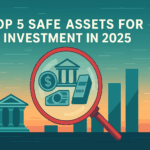After years of inflationary pressures, market volatility, and geopolitical uncertainty, 2025 has become a pivotal year for investors who prioritize capital preservation. While speculative assets remain attractive to risk-takers, a significant portion of global capital has started moving toward “safe haven” instruments.
This article highlights five of the most resilient and low-risk assets you can consider in 2025 to safeguard wealth, diversify risk, and maintain purchasing power — all based on data, trends, and institutional behaviors.
Asset #1 — U.S. Treasury Bonds (Especially TIPS)
Why Treasury Bonds Are Still King
The U.S. Treasury market remains the most liquid and trusted bond market globally. Particularly in 2025, inflation-indexed bonds such as TIPS (Treasury Inflation-Protected Securities) are drawing massive institutional interest.
Key Reasons for 2025 Popularity:
- Yields have stabilized around 3.6–4.2% for 10-year TIPS
- Inflation-linked principal adjustments offer built-in hedging
- High demand from pension funds and endowments
Risk Profile:
Extremely low, backed by the U.S. government. The primary risk comes from interest rate fluctuations and opportunity cost if rates fall.
When to Use Treasuries
- Preserving purchasing power during rising prices
- Balancing a growth-oriented portfolio
- Rebalancing out of equities in case of overvaluation
“Treasuries are less about returns and more about protecting what you already have.”
— Michael Zezas, Chief U.S. Public Policy Strategist at Morgan Stanley
Asset #2 — Physical Gold and ETFs
The Old Hedge Is Still Golden
With gold prices hovering above $2,300/oz in Q2 2025, investors continue to pour into physical bullion, allocated vault storage, and low-cost ETFs such as SPDR Gold Shares (GLD).
Advantages:
- Counter-cyclical behavior — often rises when equities fall
- No credit risk or counterparty exposure
- Inflation and currency hedge
Drawbacks:
- No yield or dividend
- Costs of storage or ETF management fees
Emerging Trend:
Many investors now buy tokenized gold via platforms like Paxos Gold (PAXG) for real-world backing with blockchain mobility.
How Gold Fits a Defensive Strategy
Gold is ideal for:
- Times of currency devaluation
- Global crises (war, debt default, economic slowdown)
- Diversifying beyond fiat-backed instruments
Asset #3 — High-Quality Dividend Stocks
Defensive Equities With Yield
Not all stocks are speculative. Some blue-chip dividend payers — particularly in the utilities, consumer staples, and healthcare sectors — have proven remarkably resilient even during downturns.
Top Examples in 2025:
- Johnson & Johnson (JNJ) — healthcare stability
- Procter & Gamble (PG) — household staple dominance
- NextEra Energy (NEE) — regulated utility with green exposure
What Makes Them Safe:
- Consistent cash flow
- Decades of dividend track record
- Regulatory protection in essential industries
Strategy Tip
Pairing these stocks with covered call options can enhance income without excessive volatility.
Asset #4 — Stablecoins (Fully Backed)
Fiat-On-Chain Safety
Stablecoins have matured by 2025, with fully reserved offerings (like USDC, TUSD, and EUROC) regulated under MiCA (EU) and stablecoin frameworks in Singapore, Canada, and the UAE.
Why Safe?
- Audited reserves with monthly attestations
- 1:1 backing with fiat in trusted banks
- Used as gateways between fiat and crypto ecosystems
Best Use Cases:
- Holding dry powder during crypto downturns
- Cross-border remittance with minimal fees
- Accessing DeFi without exposure to volatility
Risk Consideration:
Choose only regulated, attested coins. Avoid algorithmic or partially collateralized tokens (e.g., TerraUSD, which failed in 2022).
Asset #5 — Real Estate Investment Trusts (REITs)
Indirect Exposure to Tangible Assets
In 2025, real estate remains a safe haven, especially via REITs that offer access to income-producing property without owning it physically.
Top Sectors:
- Healthcare REITs — aging population demands
- Industrial REITs — e-commerce logistics growth
- Data center REITs — AI and cloud compute expansion
Key Picks:
- Digital Realty Trust (DLR)
- Welltower Inc. (WELL)
- Prologis (PLD)
Why Investors Like REITs:
- High dividend yield (often 4–6%)
- Low correlation with tech-heavy equity portfolios
- Tangible asset-backed exposure
Comparative Overview of Safe Assets in 2025
To synthesize our analysis, let’s compare the five safe assets side by side across several criteria, including risk level, expected return, liquidity, inflation protection, and ideal investor profile.
Table — Key Characteristics of the Top 5 Safe Assets
| Asset Type | Risk Level | Expected Yield (2025) | Liquidity | Inflation Hedge | Ideal For |
| U.S. Treasury Bonds (TIPS) | Very Low | 3.6–4.2% | High | Yes | Conservative, institutional |
| Physical Gold / ETFs | Low | 0% (capital gain only) | Medium to High | Strong | Crisis hedge, long-term holder |
| Dividend Stocks | Medium-Low | 3–5% + growth | High | Moderate | Balanced portfolios, income seekers |
| Regulated Stablecoins | Very Low | 0–1% (via DeFi usage) | Very High | Weak | Crypto-native, short-term cash park |
| Real Estate Trusts (REITs) | Medium | 4–6% + appreciation | Medium | Moderate | Yield-focused, real asset exposure |
Hints for Building a Low-Risk Portfolio in 2025
Diversification Is More Than a Buzzword
Even the safest asset can underperform or face pressure in extreme macroeconomic conditions. That’s why a layered approach—spanning multiple uncorrelated safe assets—tends to perform better than over-allocating to just one.
Example Low-Risk Portfolio Allocation:
- 30% U.S. TIPS (core inflation protection)
- 20% Gold ETFs or physical (crisis hedge)
- 20% Blue-chip dividend stocks (yield + moderate growth)
- 15% Stablecoins (for liquidity and on-chain activity)
- 15% REITs (real-world yield with growth)
Such a blend aims to provide income, stability, inflation protection, and access to liquid capital — making it suitable for both conservative retail investors and institutional players.
Stay Updated on Macro Signals
Key macroeconomic trends to monitor:
- Inflation rates vs. TIPS returns
- Gold price movement against central bank reserves
- Central bank interest rate policy
- DeFi regulations around stablecoins
- Dividend payout ratio changes
The more actively you track these signals, the more effectively you can adjust your exposure to maintain low risk.
Don’t Ignore Geographic Diversification
Different regions offer different safety profiles:
- U.S. Treasuries and REITs are most resilient in dollar zones
- European REITs or gold vaults may be better suited for euro-based investors
- Stablecoins may offer better remittance value in countries with capital controls
Pair your asset safety strategy with geopolitical awareness, especially in volatile currency environments.
Final Thoughts
In 2025, the pursuit of high returns is no longer the only concern — safety, liquidity, and long-term purchasing power are equally critical. Investors who balance their portfolios across reliable and regulated instruments will have the edge in volatile macroeconomic conditions.
“The most successful investors in the long run are those who respect risk as much as they pursue reward.”
— Ray Dalio, Founder of Bridgewater Associates
The rise of tokenized commodities, government-backed digital currencies, inflation-indexed treasuries, and globally accessible REITs has reshaped the meaning of safety. It’s no longer about choosing between crypto or traditional — it’s about knowing where each fits into your broader portfolio.
Frequently Asked Questions About Safe Assets in 2025
Q1: What are the safest investments in 2025 during global economic uncertainty?
The safest investments are:
- Inflation-Protected U.S. Treasury Bonds (TIPS)
- Gold (physical and ETFs)
- Blue-chip Dividend Stocks
- Stablecoins (regulated only)
- Real Estate Investment Trusts (REITs)
Each provides a different kind of protection—TIPS for inflation, gold for geopolitical crises, and stablecoins for liquidity. A diversified blend of these is often the most resilient approach.
Q2: Can stablecoins really be considered “safe” investments?
Stablecoins are relatively safe only when issued by licensed entities and backed 1:1 by cash or equivalents, such as:
- USDC by Circle
- EURe (Euro-backed stablecoins)
- SGD-based stablecoins in Asia
Risks to consider include:
- Regulatory crackdowns
- Smart contract vulnerabilities (if deployed in DeFi)
- Issuer solvency
For very short-term holdings (e.g. 30–90 days), they can be ideal for preserving value and enabling quick moves into volatile markets.
Q3: What should I avoid if I want to keep my portfolio low-risk?
Avoid:
- Speculative altcoins or memecoins, regardless of trend.
- Overexposure to a single asset class, even gold.
- Unregulated platforms, even for stablecoins.
- Leveraged ETFs or derivatives, which are not suitable for long-term safety.
While these instruments might provide momentary gains, they typically increase downside risk, which contradicts the goals of a low-risk strategy.
Q4: Are dividend stocks really “safe” if markets crash?
Dividend stocks, particularly those with a history of stable or increasing payouts, offer two layers of security:
- Steady income regardless of price movement
- Implied corporate health and strong cash flow
However, they are still equities, and their market value can drop during a crash. The safest among them are:
- Utility stocks (e.g. Duke Energy)
- Consumer staples (e.g. Procter & Gamble)
- Established telecoms (e.g. AT&T)
Their downside volatility is generally less pronounced than growth stocks, especially in recession scenarios.
Q5: What tax considerations exist for safe assets in 2025?
Here are key tax points to consider (US context, with global parallels):
- TIPS: Interest is taxed annually, but inflation adjustment is also considered taxable.
- Gold: Capital gains from physical gold are taxed at the collectibles rate (~28% in the US).
- REITs: Dividends are taxed as ordinary income, though some may qualify for a 20% deduction.
- Stablecoins: Still considered property under IRS rules, so even swapping stablecoins may trigger capital gains/losses.
- Dividend Stocks: Qualified dividends may receive favorable rates (0%, 15%, or 20%).
It’s vital to consult local regulations or a licensed advisor in your jurisdiction to avoid hidden liabilities.
Additional Insights — Where Safe Assets Are Headed
The Role of Artificial Intelligence in Safe Asset Allocation
In 2025, AI is not only managing volatile portfolios but also enhancing safe asset management:
- AI-powered platforms can:
- Detect early macroeconomic shifts (e.g. rising inflation)
- Monitor global gold reserves and central bank movements
- Suggest rebalancing before interest rate hikes
- Detect early macroeconomic shifts (e.g. rising inflation)
- Example: BlackRock’s Aladdin system uses AI to optimize fixed-income allocation for pension funds, prioritizing low-drawdown portfolios.
Expect more AI-managed risk profiles in robo-advisors, crypto apps, and institutional funds alike.
Can Geopolitical Risk Shift What’s Considered “Safe”?
Absolutely. In 2025, safe asset perception is increasingly regionalized:
- In the US, treasuries and dividend stocks dominate.
- In Asia, real estate and gold are primary hedges.
- In Africa and South America, stablecoins are key to escaping inflation or devaluation.
Future safe assets may include:
- Tokenized government bonds
- Green energy REITs
- CBDCs (if interest-bearing)
Final Verdict — Tailor Safety to Your Reality
“There is no such thing as a universally safe investment. The right asset is the one that protects your goals from your risks.”
— Howard Marks, Co-Founder of Oaktree Capital
2025 challenges investors to go beyond gold and bonds and look toward a diversified framework that includes traditional, digital, and AI-informed instruments.




